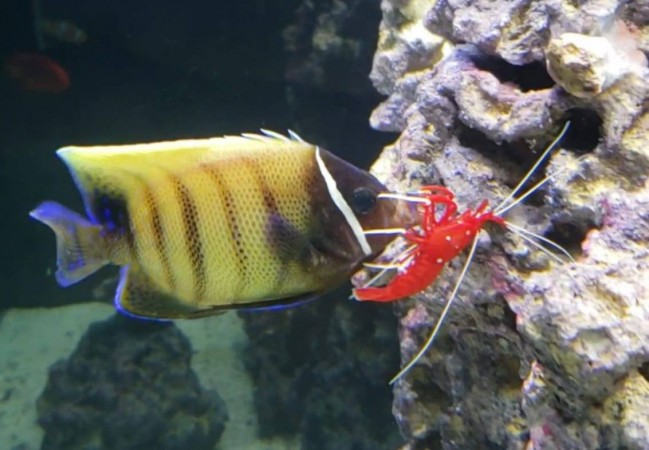Hiring a Crew to Keep Your Aquarium Clean
- May 02, 2019
- PalaciosAn
- 3826 0 0

[Picture was taken by Lou Rodia]
Finding a species of fish that is cool to look while helping reduce the amount of maintenance you need to perform in your tank or keep the species in your tank pests free preventing unwanted outbreaks of pest and algae. Utilitarian fish and invertebrates can help with a broad range of saltwater aquarium issues from preventing pests to algae outbreaks. None of the species listed below are guaranteed to prevent issues, and in most cases, they should be introduced before there is an issue in your tank.
The most popular utilitarian fish that helps control algae before it becomes an issue is a Tang fish, sometimes referred to as a Surgeon Fish. They are incredibly active fish, and most of them will spend their days pecking at the rocks where they see algae growing. Some of the most popular Tangs to prevent algae growth are Bristle Tooth Tangs, Ctenochaetus Tangs, Convict Tangs, Purple Tangs, and Yellow Tangs. Smaller tangs such as Kole Yellow Eye Tang, Chevron Tang, and White Tail Tangs are ideal for medium sized tanks. Tangs are not suitable for small tanks. Some of these tangs as juveniles can be kept in smaller tanks, but they will quickly outgrow them. When that happens you will need to rehome them or take them back to your Local Fish Store. Just about every Tang will eat algae. Some genus such as the Acanthurus Tangs maybe less effective algae eaters which include Powder Blue Tang, Powder Brown Tang, and my personal favorite the Achilles Tang.
If you’re considering adding more than one Tang to your aquarium the best way to do it is to add them all at the same time. This way it allows them to establish a territory and dominance all at once. Sometimes, when you add additional Tangs to an established tank the original Tang(s) will show aggression towards the new Tang(s). There are ways to try to reduce this aggression, but it is not always successful. See this article “Thinking About Getting a Tang Fish?”.
Besides Tang fish, the Foxface Rabbitfish is also an aggressive algae eater and a good choice for algae control. The biggest issue with them is the dorsal spines are venomous so you must be cautious when placing your hands in the tank. They also require medium to large aquariums.
If you are looking for algae eaters for smaller aquariums you are out of luck. There are some Blendies fish which are known to eat algae such as the Lawn Mower Blendy. Unfortunately, they are less effective in preventing algae outbreaks and controlling algae. For a small tank, your best bet for algae control is regularly scheduled maintenance, water changes and a good cleaner crew of invertebrates. Urchins are excellent algae eaters and can help prevent algae outbreaks, the biggest issue with urchins is that they act like a bulldozer and will push anything out of the way that is not secured down correctly. They're also known to carry items away including corals. They will even eat and control Coraline algae growth.
When it comes to controlling pests Wrasses lead the charge as they are continually moving and hunting pests, worms, and copepods throughout your aquarium. They can track down nudibranch, flatworms and many more. Popular species include Six Line Wrasse, Eight Line Wrasse, and Mystery Line Wrasse. The Halichoeres Wrasse family are good options also some of the most popular choices are Yellow Course Wrasse, Radiant Wrasse, and Melanurus Wrasse. Some Wrasses need a sand bed substrate because when they feel threatened or when they go to sleep, they dive into the sand bed for protection.
If you have a coral with pests that cannot be removed from your aquarium to dip and quarantine, some hobbyist use Wrasse to control them. Some hobbyist claim Wrasse eradicated the pest. In most cases, the Wrasse can be used to keep them under control and prevents them from spreading further. If your issue is with Flatworms another good option is Scooter Blennies.
When it comes to controlling Parasitic Copepods, Dragonets will go through your tank continually hunting them down. They may not eat as many different pests as a Wrasse, but they are ferocious Copepods hunters. Popular species include Green Mandarin, Red Mandarin, and Yellow Mandarin. Dragonets are beautiful fish but you only want to add them to a well-established aquarium. Dragonets are very picky eaters and getting them to eat processed/frozen foods can be difficult, and they may only eat copepods. For this reason, it's suggested to have an established tank with lots of copepods already in your aquarium. Without them, you will have to raise or purchase pods for your tank to feed them.
One of the best ways to prevent pests from being introduced to your aquarium is to quarantine everything you put in your display tank. To truly quarantine means quarantining everything including rock, fish, invertebrates, and corals. Anything that you add to your aquarium can be a source that introduces unwanted pests. To learn more about the quarantine process check out “Why Don't You Quarantine.”
Another option you should consider is a UV Sterilizer. It can help control algae outbreaks and floating pathogens. Even if you add a UV Sterilizer, it doesn't mean you should not quarantine everything that comes into your display tank. UV Sterilizers will not completely prevent all algae and pests, just the same as a skimmer will not remove all proteins from the water. It should be viewed as a piece of hardware that can help you be a little more successful.
Comment below, what have you added to your tank to help reduce your maintenance to your aquarium?






About author
I have been in the hobby for a while, my main focus is automation. I am interested in doing aquaponics in 2018.